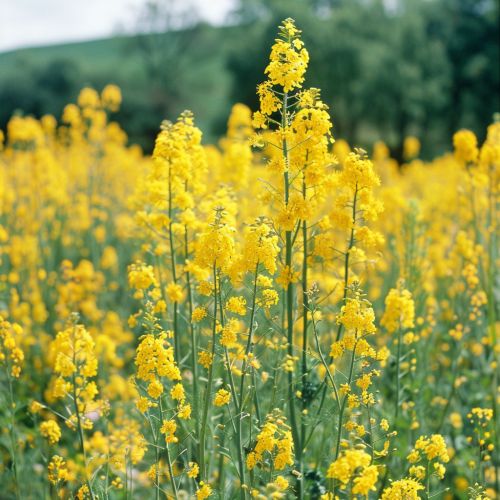Brassicaceae: Difference between revisions
(Created page with "== Overview == The Brassicaceae, also known as the Cruciferae, is a large family of flowering plants commonly referred to as the mustard family. This family includes a variety of economically important crops, ornamental plants, and weeds. The Brassicaceae family is characterized by its unique floral structure, which typically includes four petals arranged in a cross shape, hence the name "Cruciferae." This family is notable for its significant role in agriculture, hortic...") |
No edit summary |
||
| Line 70: | Line 70: | ||
The Brassicaceae family is a diverse and economically significant group of plants. Its members play vital roles in agriculture, medicine, and ecological systems. Ongoing research and conservation efforts are essential to ensure the sustainability and preservation of this important plant family. | The Brassicaceae family is a diverse and economically significant group of plants. Its members play vital roles in agriculture, medicine, and ecological systems. Ongoing research and conservation efforts are essential to ensure the sustainability and preservation of this important plant family. | ||
[[Image:Detail-92549.jpg|thumb|center|Field of blooming mustard plants.|class=only_on_mobile]] | |||
[[Image:Detail-92550.jpg|thumb|center|Field of blooming mustard plants.|class=only_on_desktop]] | |||
== See Also == | == See Also == | ||
Latest revision as of 15:48, 16 June 2024
Overview
The Brassicaceae, also known as the Cruciferae, is a large family of flowering plants commonly referred to as the mustard family. This family includes a variety of economically important crops, ornamental plants, and weeds. The Brassicaceae family is characterized by its unique floral structure, which typically includes four petals arranged in a cross shape, hence the name "Cruciferae." This family is notable for its significant role in agriculture, horticulture, and biological research.
Taxonomy and Classification
The Brassicaceae family belongs to the order Brassicales. It comprises approximately 372 genera and over 4,060 species. The family is divided into several subfamilies and tribes based on morphological and genetic characteristics. Key genera within the Brassicaceae family include Brassica, Arabidopsis, Raphanus, and Sinapis.
Subfamilies and Tribes
The Brassicaceae family is divided into several subfamilies and tribes, each with distinct characteristics. Some of the notable subfamilies include:
- **Brassicoideae**: This subfamily includes the genus Brassica, which contains important crops such as cabbage, broccoli, and mustard.
- **Aethionemoideae**: A small subfamily with a limited number of genera, primarily found in the Mediterranean region.
- **Camelineae**: This tribe includes the model organism Arabidopsis thaliana, widely used in plant genetics and molecular biology research.
Morphology
The Brassicaceae family exhibits a wide range of morphological diversity. However, several key features are commonly observed across the family.
Floral Structure
The flowers of Brassicaceae are typically actinomorphic (radially symmetrical) and hermaphroditic. They usually have four sepals, four petals arranged in a cross shape, six stamens (four long and two short), and a single pistil. The ovary is superior, and the fruit is typically a silique or silicle.
Leaves and Stems
Leaves in the Brassicaceae family are generally simple, alternate, and often lobed or divided. They may be sessile or petiolate. The stems are usually herbaceous, although some species exhibit woody growth.
Roots
The root systems of Brassicaceae species vary widely, ranging from taproots to fibrous root systems. Some species, such as radishes, have enlarged storage roots.
Economic Importance
The Brassicaceae family includes several species of significant economic importance. These plants are cultivated for their nutritional, medicinal, and industrial uses.
Agricultural Crops
Several Brassicaceae species are essential agricultural crops. Notable examples include:
- **Brassica oleracea**: This species includes a variety of vegetables such as cabbage, broccoli, cauliflower, kale, and Brussels sprouts.
- **Brassica napus**: Commonly known as rapeseed, this species is cultivated for its oil-rich seeds, which are used to produce canola oil.
- **Raphanus sativus**: Known as radish, this species is grown for its edible root.
Medicinal Uses
Many Brassicaceae species have been used in traditional medicine for their therapeutic properties. For example, mustard seeds (Brassica nigra) have been used for their anti-inflammatory and antimicrobial properties.
Industrial Uses
Several species within the Brassicaceae family are used in industrial applications. For instance, the oil extracted from Brassica napus seeds is used in the production of biodiesel.
Ecological Significance
The Brassicaceae family plays a crucial role in various ecosystems. These plants are often pioneer species, colonizing disturbed soils and contributing to soil stabilization and fertility.
Pollination and Seed Dispersal
Brassicaceae flowers are primarily pollinated by insects, although some species are self-pollinating. Seed dispersal mechanisms vary, with some species relying on wind, water, or animal vectors.
Interactions with Other Organisms
Brassicaceae species engage in various ecological interactions, including mutualistic relationships with pollinators and antagonistic interactions with herbivores and pathogens. Some species produce glucosinolates, secondary metabolites that deter herbivores and pathogens.
Genetic and Molecular Research
The Brassicaceae family has been a focal point of genetic and molecular research, particularly the genus Arabidopsis. Arabidopsis thaliana, a small flowering plant, has become a model organism due to its small genome, short life cycle, and ease of genetic manipulation.
Arabidopsis thaliana
Arabidopsis thaliana has been instrumental in advancing our understanding of plant biology. Research on this species has led to significant discoveries in areas such as plant development, hormone signaling, and stress responses.
Genomic Studies
The Brassicaceae family has been the subject of extensive genomic studies. The sequencing of the Arabidopsis thaliana genome in 2000 marked a milestone in plant genomics. Subsequent studies have focused on comparative genomics, revealing insights into the evolution and diversification of the family.
Conservation and Threats
Several Brassicaceae species are threatened by habitat loss, climate change, and other anthropogenic factors. Conservation efforts are underway to protect these species and their habitats.
Conservation Strategies
Conservation strategies for Brassicaceae species include habitat preservation, seed banking, and ex situ cultivation. Organizations such as the International Union for Conservation of Nature (IUCN) play a crucial role in these efforts.
Threatened Species
Some Brassicaceae species are listed as threatened or endangered. For example, the rare plant species Erysimum menziesii, native to California, is endangered due to habitat destruction and invasive species.
Conclusion
The Brassicaceae family is a diverse and economically significant group of plants. Its members play vital roles in agriculture, medicine, and ecological systems. Ongoing research and conservation efforts are essential to ensure the sustainability and preservation of this important plant family.


